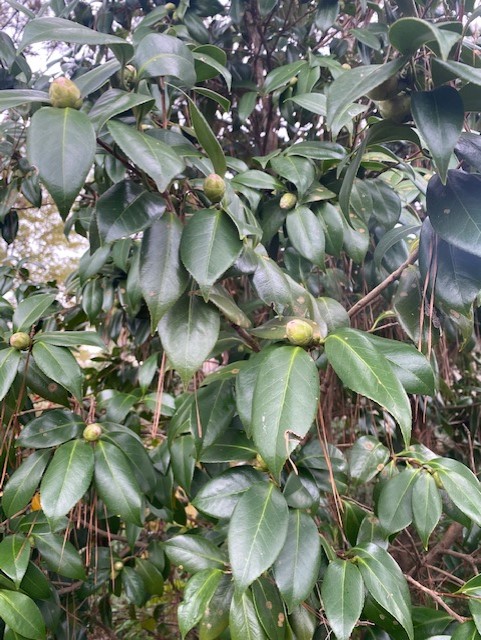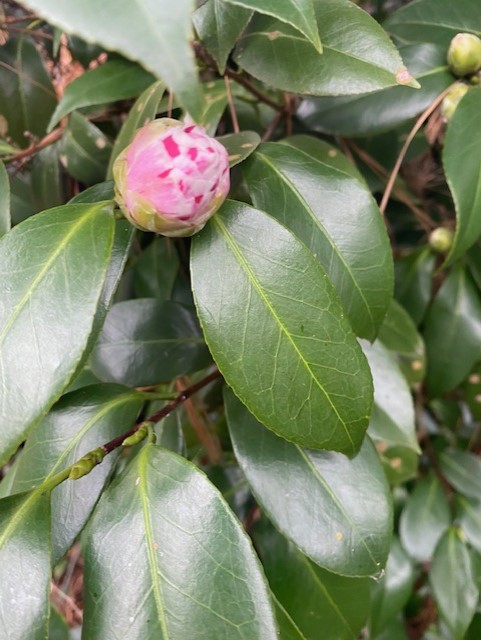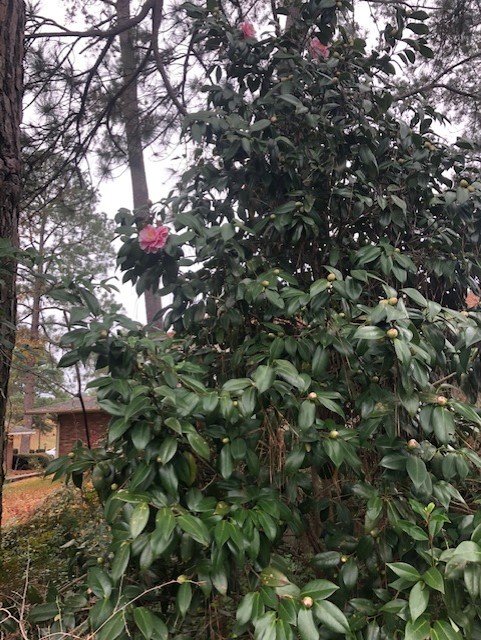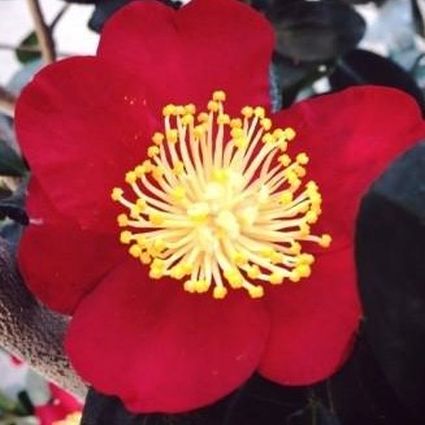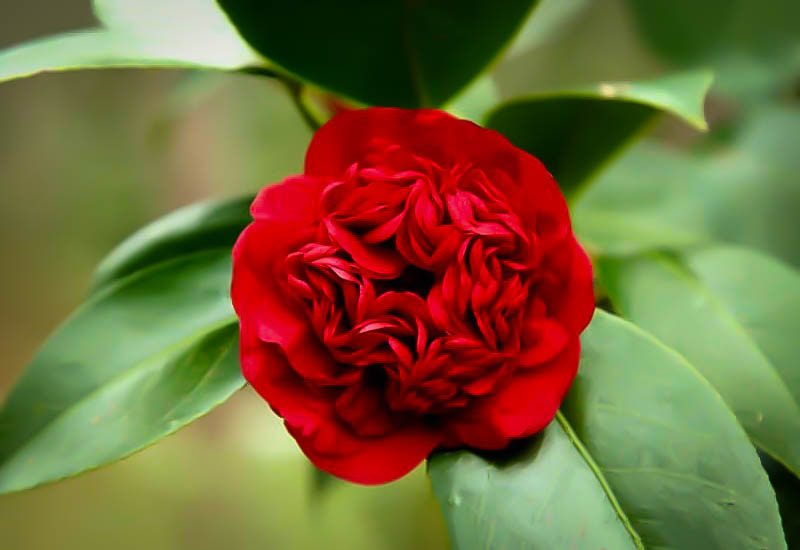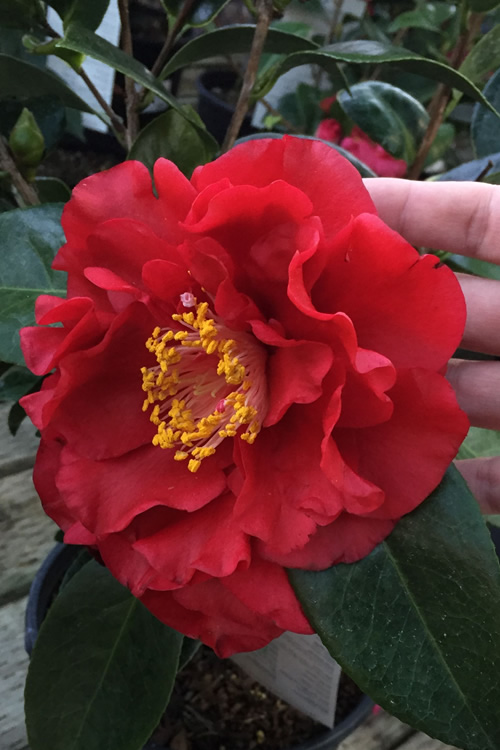
“The camellias. I could see them, seemingly endless rows of big, bushy green trees with waxy leaves and showy flowers the size of saucers. Pinks, reds- bursting into bloom, as if they’d been painted by the Queen of Hearts.”
―
In November, I began to see buds on my camellia. I watched every day as they swelled. Just before Christmas, they began to bloom. It is loaded with buds which unfold almost daily. The camellia will continue her show for several more weeks.
 It is so delightful to have something in bloom when skies are gray and the temperatures can go from 60’s to frigid in the blink of an eye. Perhaps that’s why camellias are referred to as the “ultimate winter surprise.”
It is so delightful to have something in bloom when skies are gray and the temperatures can go from 60’s to frigid in the blink of an eye. Perhaps that’s why camellias are referred to as the “ultimate winter surprise.”
This camellia, the Herme variety, has made quite the progress over the years. It was given to me by a dear friend and former boss, Sharon Lyon, as a birthday gift during our time together at the American Red Cross. It was about a foot tall then, about 12 years ago, now it towers around 9′ tall. It’s very majestic with shiny dark green leaves and beautiful prolific pink and white blooms!
Camellias have been prized possessions of gardeners for decades. They thrive in mild climates from California to Florida and are available in thousands of cultivars. These broadleaved evergreen shrubs have durable, glossy foliage and gorgeous flowers. The most common species of camellias are Camellia japonica and Camellia sasanqua.
Here is what you need to know about growing camellias:
Zones:
Commonly, 7-10. New varieties bred from C. oleifera such as ‘Survivor’ and ‘Winter’s Rose’, are hardy to Zone 6.
Height/Spread:
Most shrubs reach a height between 6 and 12 feet, and just about as wide.
Exposure:
Part shade to full shade. Most prefer dappled light, but a few varieties need (or tolerate) more sun than others. In general, red-flowered varieties can withstand more sun than white varieties.
Bloom time:
Different varieties of camellias bloom from late fall to mid-spring. Stagger plantings of early, mid- and late varieties and you can have flowers from November through April or May. C. sasanqua tends to bloom earlier, mid-fall to early winter. C. japonica blooms from mid-winter to spring. Hybrid bloom times will vary depending on variety.
Flower color and characteristics:
Beautiful flowers, mainly white and shades of pink or red, and various combinations. They come in various shapes: anemone, single, semi-double, formal double, rose-form double and peony form.
Life span:
Camellias are long-lived plants, with some living more than 100 years.
When to plant:
In zones 8-10, camellias can be planted in the fall, winter or spring. However, in zone 6 or 7, they are better planted in spring to allow their roots time to establish before colder weather sets in.
Where to plant:
Site in a location protected from wind. In hot climates, locate where they are protected from bright light or leaves may be scalded by the sun.
How to plant:
Plant level with the soil surface; especially avoid planting too deep. The planting hole should be as deep as the rootball and twice as wide. Refill and pack down the bottom 3-4 inches of the hole. Center the plant and fill, sloping the soil up the sides. The top of the rootball should be 2-4 inches above the soil level. Don’t cover the top of the rootball, but mulch around the plant with no more than 1 inch covering the rootball. Water well.
Planting in containers:
Camellias are great for well-draining containers and should be planted with potting mix containing 50 percent or more organic material. Choose smaller, slower-growing varieties.
Caring for your camellias:
Soil:
Should be well-drained with a pH of 6 to 6.5 (slightly acid). Keep it moist.
Amendments:
Keep roots cool with a 2-inch layer of mulch such as pine straw or ground bark. Avoid “mulch volcanoes”; as Celeste Richard, executive director of the American Camellia Society, says, “mulch out, not up.” Feed with one of many available camellia fertilizers or a general 10-10-10 fertilizer in spring after the flowers have dropped. Avoid feeding camellias after July, as late feeding can cause bud drop.
Water:
Water regularly for the first couple of years, then keep soil moist, but not too wet. Provide summer water in dry climates.
Pruning:
Pruning is rarely needed, but it helps to remove crossover limbs or diseased/dead wood. This can be done after blooming has finished in spring.
Diseases/Pests:
For pests, natural products are available, such as neem oil. Camellia petal blight affects flowers and buds, turning them an unsightly brown. This is best avoided by removing spent flowers and not letting old flowers linger on the soil surface. Dispose of flowers in garbage; do not compost, as composting will likely spread the fungal spores.
My goal for the coming year is to plant another camellia in the front flower bed of my house. I am leaning towards a red one because I think it will be beautiful to have those stunning red blooms come Christmas!
These are the varieties I am looking at. Which would you choose?

